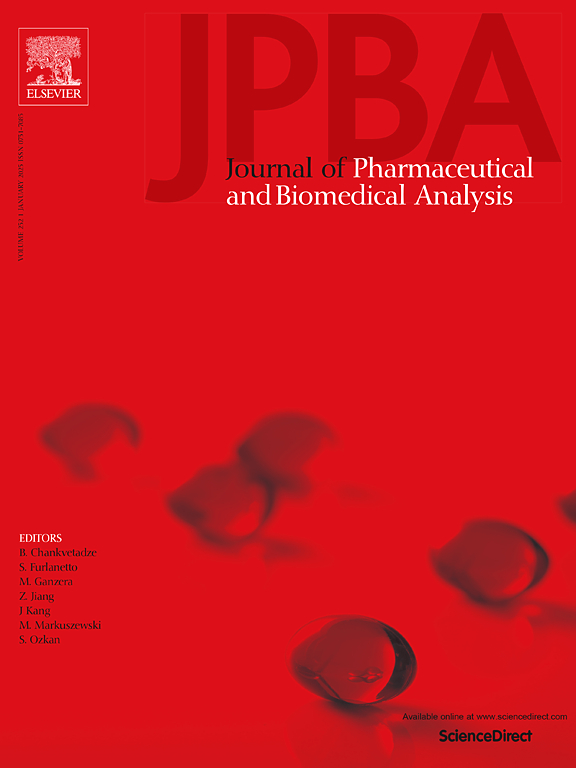薄荷精油的表征、鉴别和掺假检测:核磁共振方法
IF 3.1
3区 医学
Q2 CHEMISTRY, ANALYTICAL
Journal of pharmaceutical and biomedical analysis
Pub Date : 2025-05-01
DOI:10.1016/j.jpba.2025.116941
引用次数: 0
摘要
薄荷精油(PEO)是一种珍贵的天然产品,广泛应用于食品、化妆品和治疗中。然而,它的质量和真实性经常受到掺假和成分变化的影响。本研究探讨了核磁共振(NMR)技术在PEO表征和鉴别中的应用,以及在商业PEO样品中掺假的鉴定。综合分析一维和二维核磁共振光谱,可以识别与PEO关键成分相关的特征¹H核磁共振信号,并揭示了不同地理来源的PEO之间的显著成分差异。为了便于区分,开发了一种直接的指标比率方法来区分美国和印度这两个主要生产区的peo。使用核磁共振结合化学计量工具对总共50个商业PEO样品进行了评估,发现掺假率很高(42% %)。掺假物包括合成化学品、去薄荷油和低成本油。这项工作证明了核磁共振作为精油质量评估和真实性测试的有用工具的潜力。所提出的方法也可以扩展到其他精油,以确保产品的完整性。本文章由计算机程序翻译,如有差异,请以英文原文为准。
Characterization, differentiation, and adulteration detection of peppermint essential oil: An NMR approach
Peppermint essential oil (PEO) is a valuable natural product widely used in food, cosmetics, and therapeutics. However, its quality and authenticity are frequently compromised by adulteration and compositional variability. This study explored the application of Nuclear Magnetic Resonance (NMR) technique for the characterization and differentiation of PEO, as well as for the identification of adulterants in commercial PEO samples. Comprehensive analyses of 1D and 2D NMR spectra allowed for the identification of characteristic ¹H NMR signals associated with the key components of PEO, and significant compositional variations between PEOs from different geographical origins were revealed. To facilitate differentiation, a straightforward indicator ratio method was developed to distinguish between PEOs from the United States and India, the two primary production regions. A total of 50 commercial PEO samples were evaluated using NMR in combination with chemometric tools, uncovering a high adulteration rate (42 %). Adulterants, including synthetic chemicals, de-mentholized cornmint oil, and lower-cost oils, were identified. This work demonstrates the potential of NMR as a useful tool for quality assessment and authenticity testing of essential oils. The methodology presented may also be extended to other essential oils to ensure product integrity.
求助全文
通过发布文献求助,成功后即可免费获取论文全文。
去求助
来源期刊
CiteScore
6.70
自引率
5.90%
发文量
588
审稿时长
37 days
期刊介绍:
This journal is an international medium directed towards the needs of academic, clinical, government and industrial analysis by publishing original research reports and critical reviews on pharmaceutical and biomedical analysis. It covers the interdisciplinary aspects of analysis in the pharmaceutical, biomedical and clinical sciences, including developments in analytical methodology, instrumentation, computation and interpretation. Submissions on novel applications focusing on drug purity and stability studies, pharmacokinetics, therapeutic monitoring, metabolic profiling; drug-related aspects of analytical biochemistry and forensic toxicology; quality assurance in the pharmaceutical industry are also welcome.
Studies from areas of well established and poorly selective methods, such as UV-VIS spectrophotometry (including derivative and multi-wavelength measurements), basic electroanalytical (potentiometric, polarographic and voltammetric) methods, fluorimetry, flow-injection analysis, etc. are accepted for publication in exceptional cases only, if a unique and substantial advantage over presently known systems is demonstrated. The same applies to the assay of simple drug formulations by any kind of methods and the determination of drugs in biological samples based merely on spiked samples. Drug purity/stability studies should contain information on the structure elucidation of the impurities/degradants.

 求助内容:
求助内容: 应助结果提醒方式:
应助结果提醒方式:


